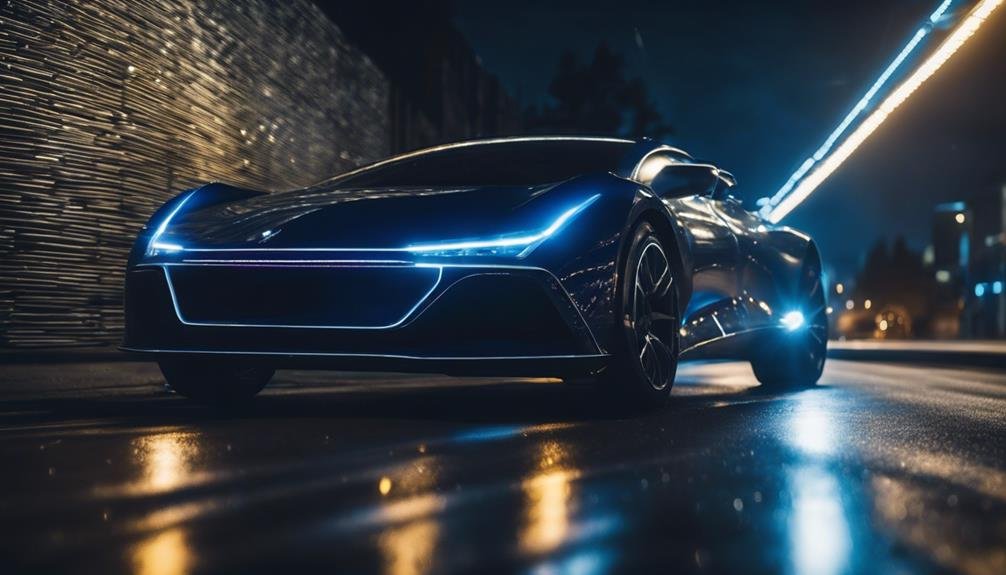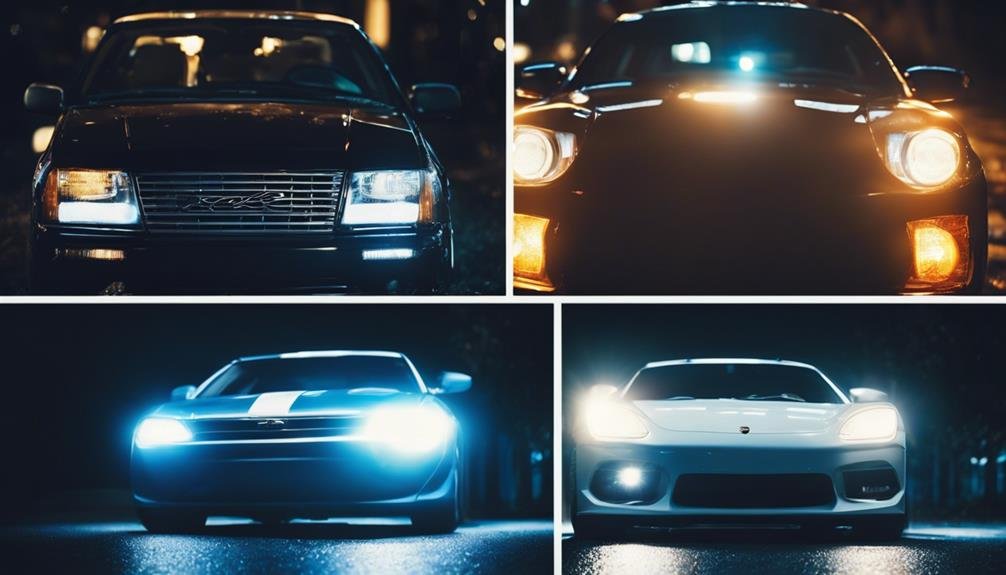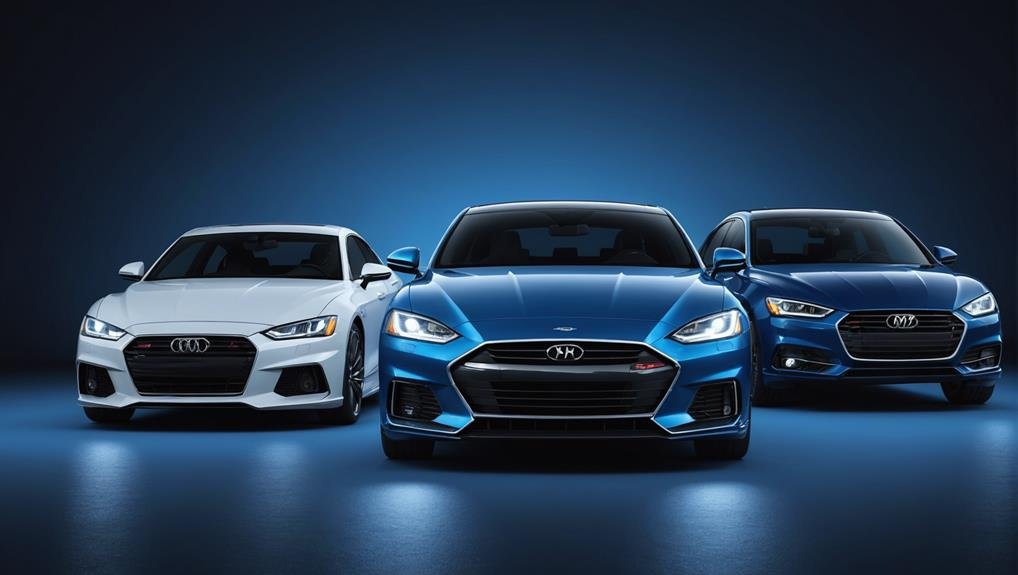When selecting headlights, you're presented with three main options: halogen, LED, and HID. Halogen headlights are the most common, emitting a yellowish light, but have a shorter lifespan and are less energy-efficient than their counterparts. LED headlights are energy-efficient, with a lifespan of around 50,000 hours, and provide a significant improvement in brightness. HID headlights, on the other hand, operate by passing an electrical current, creating a brighter light output than halogen headlights. Each type has its unique characteristics, advantages, and disadvantages, impacting your driving experience, safety, and vehicle maintenance. As you investigate each option, you'll uncover more about their features, benefits, and trade-offs.
Key Takeaways
- Halogen headlights are the most common type, emitting yellowish light, with a short lifespan of around 2,000 hours and lower energy efficiency.
- HID headlights operate by passing an electrical current, producing a brighter light output than halogen, with a lifespan of 2,000 to 8,000 hours.
- LED headlights are energy-efficient, consuming 32W of power, with a lifespan of approximately 50,000 hours, and provide a significant improvement in brightness.
- Each type of headlight has its strengths and weaknesses, with halogen being cost-effective, HID offering high brightness, and LED providing energy efficiency and long lifespan.
- When choosing a headlight type, consider factors such as brightness, energy efficiency, lifespan, and cost to select the best option for your needs.
Understanding Halogen Headlights
You're likely familiar with halogen headlights, as they're the most common type found in vehicles today, making up over 80% of cars on the road. These headlights operate in the same way as traditional incandescent light bulbs, emitting a yellowish light that's less bright compared to other types. The bulbs themselves have a relatively short lifespan of around 2,000 hours, making them less durable than HID and LED options.
While they may not be as energy-efficient as their counterparts, halogen headlights are more affordable and easy to replace. Their simplicity and cost-effectiveness make them ideal for short-distance daily drivers looking for a basic lighting solution. However, if you're looking for a more energy-efficient option, you may want to explore alternatives.
Despite this, halogen headlights remain a popular choice for many vehicle owners, offering a reliable and affordable lighting solution. In general, understanding halogen headlights is crucial for making informed decisions regarding your vehicle's lighting system.
How HID Headlights Work
HID headlights operate by passing an electrical current between tungsten electrodes to ignite xenon gas, creating a noticeably brighter light output compared to halogen bulbs. As you investigate how HID headlights function, you'll find that the electric arc created within the HID bulb produces a markedly brighter light output. This is due to the high-intensity discharge that occurs when the electrical current passes between the tungsten electrodes, igniting the xenon gas.
This process results in a brighter light that's more efficient and longer-lasting, with a typical lifespan of around 2,000 to 8,000 hours. To maintain proper functionality, HID headlights require a ballast and sometimes an ignitor to regulate the electrical current. The benefits of HID headlights, including their efficiency and longevity, have made them a popular choice in modern vehicles, providing improved visibility and an enriched driving experience.
Benefits of LED Headlights

When it comes to illuminating the road ahead, LED headlights offer a multitude of benefits that make them an attractive alternative to traditional halogen and HID bulbs.
As you consider upgrading your vehicle's lighting system, you'll appreciate the energy efficiency of LED headlights, which consume a mere 32W of power. This not only reduces your carbon footprint but also saves you money on fuel costs.
With a lifespan of approximately 50,000 hours, LED headlights are an investment that will last for years to come, reducing the need for frequent replacements.
You'll also notice a significant improvement in brightness, with LED headlights providing a more focused and intense illumination that boosts visibility on the road. Moreover, their lightweight design makes them easy to install and maintain.
While the upfront cost of LED headlights may be higher, the long-term benefits and durability make them a worthwhile investment for any driver.
Comparison of Light Output
Regarding raw brightness, LED headlights surpass traditional halogen bulbs, emitting up to 3,000 lumens of light output. Comparatively, halogen headlights typically produce around 700 lumens, showcasing a significant disparity in brightness. HID headlights, on the other hand, are recognized for their intensity, with light outputs ranging from 2,800 to 3,500 lumens.
Concerning light output, LED headlights provide a more focused and precise beam in contrast to halogen and HID bulbs. The light output of HID headlights is often depicted as more intense and penetrating than halogen or LED lights, making them well-suited for high-speed driving. If your priority is brightness, HID headlights might be the preferable option. However, if you prefer a more focused beam, LED headlights are the superior choice.
Ultimately, the decision between Halogen, HID, and LED headlights boils down to your personal preference and driving habits. By comprehending the variances in light output, you can make an informed decision when selecting the appropriate headlights for your vehicle.
Lifespan and Durability

Regarding lifespan and durability, you'll notice significant differences between halogen, HID, and LED headlights. When considering longevity, each type of headlight has its own strengths and weaknesses.
Here are the lifespans of each type:
- Halogen headlights: 450 to 1,000 hours, lasting nearly three years with daily usage.
- HID headlights: at least 2,000 hours, and can even reach up to 8,000 hours in some cases.
- LED headlights: an exceptional lifespan of around 50,000 hours.
As you can observe, LED lights are renowned for their durability and longevity, making them a great option for those seeking a long-lasting and energy-efficient solution.
Conversely, halogen headlights have a relatively shorter lifespan, necessitating more frequent replacements. HID bulbs fall somewhere in between, providing a decent balance between durability and performance.
When selecting the appropriate headlights for your vehicle, take into account the lifespan and durability of each option to make an informed decision.
Energy Efficiency Comparison
When it comes to energy efficiency, you'll find significant differences between halogen, HID, and LED headlights. Each type consumes varying amounts of power to produce the same level of brightness.
When considering power consumption, halogen bulbs are the least energy-efficient, using around 56.7W of power.
In comparison, HID bulbs offer better energy efficiency, consuming approximately 49.1W of power. However, LED bulbs take the lead in energy efficiency, using a mere 32W of power, making them the top choice for saving energy.
Interestingly, HID bulbs peak in power consumption initially and then stabilize, providing a balance between brightness and efficiency. On the other hand, LED bulbs have the lowest power consumption among the three types, making them a sustainable and eco-friendly lighting option.
In general, if energy efficiency is a top priority, LED bulbs are the way to go. By choosing LED headlights, you'll not only reduce your carbon footprint but also enjoy significant energy savings over time.
Cost and Replacement

What's the best way to balance your budget with your desire for quality headlights, taking into account the varying costs and replacement needs of halogen, HID, and LED options?
When evaluating cost and replacement, each type of headlight has its pros and cons.
- Halogen headlights: The most cost-effective option, with bulbs typically priced around $15 each, but with shorter longevity.
- HID headlights: Falling between halogen and LED regarding cost, with bulbs generally priced higher than halogen but lower than LED.
- LED headlights: While more expensive upfront, offering long-term savings due to their energy efficiency and durability, making them a cost-effective option in the long run.
Regarding replacement costs, halogen headlights are relatively low compared to HID and LED options. However, LED headlights may have a higher initial cost, but they provide cost savings over time due to their longevity and efficiency.
Safety Features and Drawbacks
As you evaluate the cost and replacement needs of different headlight types, it's equally important to contemplate their safety features and drawbacks, which can greatly influence your driving experience.
When comparing HID vs LED headlights, safety features and drawbacks become vital considerations. HID headlights, with their exceptional brightness, can be a significant safety asset, but they may also cause glare to oncoming motorists, compromising their safety.
In contrast, LED headlights are known for their energy efficiency and long lifespan, making them a reliable choice. However, their brightness, although impressive, may not match that of HID headlights.
Halogen headlights, though common, have a shorter lifespan and lower brightness compared to LED and HID options. When weighing your options, consider the trade-offs between brightness, energy efficiency, and potential drawbacks like glare.
Upgrade and Conversion Options

Upgrading your headlights to LED or HID technology requires thoughtful evaluation of conversion options. The process involves understanding technical differences and potential physical compatibility issues. You'll need to take into account the unique requirements of LED and HID bulbs, which are smaller and operate differently than traditional halogen lights. This may require a conversion kit for proper installation, and you'll need to verify that your vehicle is compatible with the new technology.
Here are three crucial factors for a successful upgrade:
- Technical variances: LED and HID bulbs have distinct power and heat management requirements, which can impact installation and performance.
- Physical suitability: The smaller size and unique shape of LED and HID bulbs may necessitate modifications to your vehicle's headlight assembly.
- Installation intricacy: Upgrading headlights involves additional time and effort due to differences in technology and installation requirements.
Frequently Asked Questions
What Are the Three Types of Headlights?
You're wondering what types of headlights exist, and the answer is simple: you've got halogen, LED, and HID options, each with its own strengths and weaknesses, and each shining bright in its own way!
Which Is Better, Halogen HID or Led?
When deciding between halogen, HID, or LED headlights, you're likely considering brightness, efficiency, and lifespan. If you prioritize brightness, HID is the clear winner, but if energy efficiency is key, LED might be the better choice for you.
How Do I Know if My Headlights Are HID or Halogen?
You're wondering if your headlights are HID or halogen. Check the light's color and brightness: if it's blue-white and super bright, it's likely HID; if it's yellowish and dimmer, it's probably halogen.
What Are the Three Headlight Bulbs?
You're wondering what the three headlight bulbs are, and the answer is simple: halogen, LED, and HID. These three types of headlights have distinct characteristics, but they all serve the same purpose – to illuminate the road ahead.
Conclusion
Having delved into the world of headlights, you've likely gained a better understanding of the pros and cons of halogen, HID, and LED options. Each type has its strengths and weaknesses, from light output and lifespan to energy efficiency and cost.
By considering these factors, you can make an informed decision about which headlights are right for your vehicle, ensuring a safer, more enjoyable driving experience.
